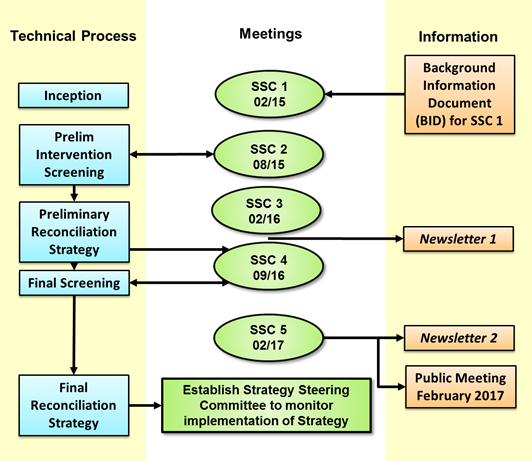|
The study approach of the Limpopo Water Management Area (WMA) North Reconciliation Strategy is based on interaction between the Public Participation Process and the Technical Process as shown in the figure below.

Schematic representation of the Study Approach
Public Participation Process
Stakeholder engagement, underpinned by effective administrative support, is a key to the successful implementation of the Limpopo WMA North Reconciliation Strategy. Communication, sharing of information and engagement between members of the DWS, SSC and PSP structures are vital.
The logistics and arrangements of the SSC and other related meetings will be undertaken. Invitations to meetings will be distributed to all members together with a response sheet, an agenda as well as the relevant documents to be discussed at the meetings.
The SSC meetings will notify all directly involved stakeholders on the study and its progress. Several other sectors of stakeholders (agriculture, industry, local government, domestic users) will be kept informed and engaged in the study. The following activities are planned to keep stakeholders informed:
- Background information documents: Background information documents (BID) will be compiled and distributed to stakeholders to provide a description of the anticipated outcomes of the study, the steps to be taken, when stakeholders may provide their inputs and also proposed timelines. Links to the Background information documents (BID) are found in
Reports Documents.
- Newsletters: Two editions of the Limpopo WMA North Reconciliation
Strategy News will be distributed to all stakeholders to provide an update on progress made with the study and the way forward. Links to the Newsletters are found in Reports Documents..
- Access to information: The DWS project web site will publish all project
documents to stakeholders to review and comment on.
Technical Process
The process begins with a review and summary of the previous studies and the current available information.
From the summary of studies and the list of options one will be able to identify which of the options appear definitely “unacceptable” because of technical findings from previous studies, political unacceptability, realities on the ground, etc. A screening workshop with the Key Stakeholders will be arranged for dividing the options into two groups, i.e. those that deserve further investigation (those with potential and those that are possibilities) and those that can be rejected outright.
The next action will be to look at all the options that need further investigations and decide what further information is necessary. Certain modelling scenarios will also be identified.
Once a clear picture is formed of which options need to be investigated, their feasibility will be determined. The environmental impacts of each promising option will also be assessed.
After having screened the options once again, and after determining the environmental impacts, the best options will be selected and the reconciliation strategies will be compiled.
The preliminary reconciliation strategy will be formulated halfway through the Study and will contain obvious and “quick win” interventions. The reconciliation final strategy will be delivered towards the end of the study after further investigations have been completed.
The Technical Process and the process of selecting the options in particular, will be conducted in consultation with the Key Stakeholders (Study Steering Committee) and public will be kept informed.
The diagram in the figure belowdepicts the interaction between Technical Process and the Study Steering Committee (Key Stakeholders):

Interaction between the Technical Process and the Study Steering Committee
|